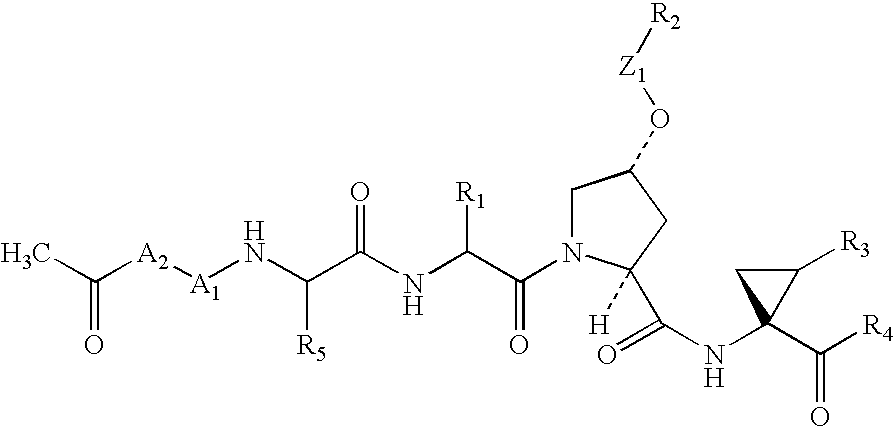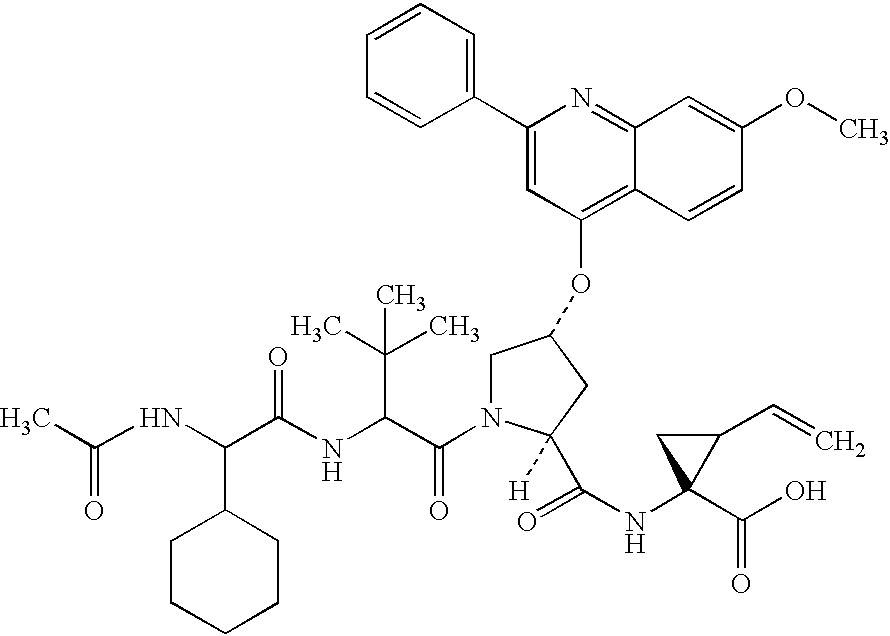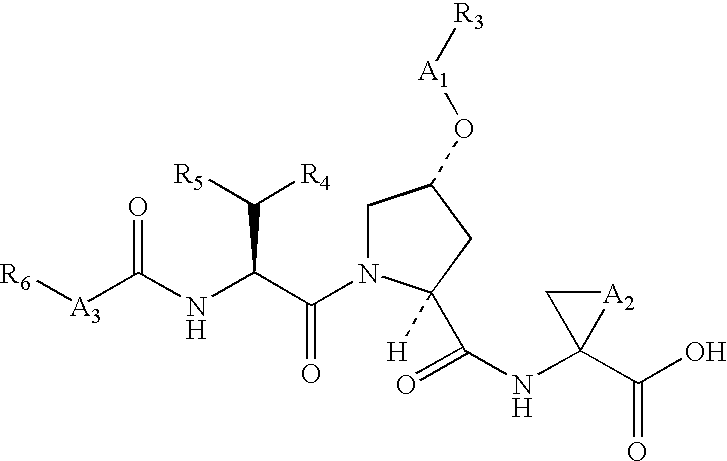Macrocyclic NS3-serine protease inhibitors of hepatitis C virus comprising N-cyclic P2 moieties
a technology of ns3serine protease and hepatitis c virus, which is applied in the direction of chemical treatment enzyme inactivation, drug composition, peptide, etc., can solve the problems of low sustained response rate of therapies, frequent side effects, and poor treatment effect of patients with hcv infection
- Summary
- Abstract
- Description
- Claims
- Application Information
AI Technical Summary
Benefits of technology
Problems solved by technology
Method used
Image
Examples
example 1
Preparation of Compounds of Formulas 1A and 1B
To a solution of Boc-Hyp-OH (7.0 g, 30.3 mmol) and benzyl 3-bromopropyl ether (7.8 g, 34.0 mmol) in anhydrous DMF (400 mL) at room temperature was added sodium hydride (3.5 g, 60% dispersion in mineral oil, 87.5 mmol) and sodium iodide (0.5 g, 3.33 mmols) with stirring. The resulting suspension was vigorously stirred at room temperature overnight (18 h). The reaction was quenched carefully with a slow addition of water (50 mL) and acidified with 6 N HCl solution (20 mL). After addition of ethyl acetate (800 mL), brine (150 mL) and more water (150 mL), the formed two layers were separated and the organic layer was washed with 5% H3PO4 (3×200 mL). It was then dried with MgSO4, filtered and concentrated in vacuo to afford I b as an oil which was used in Step B without further purification.
The acid 1b from Step A was dissolved in benzene (25 mL) and methanol (28 mL). To this solution at room temperature was added a solution of trimethylsily...
example 2
Preparation of Compound 2
The desired compound 2a was prepared according to the method of Example 1, Step J, except for substituting the amine B for the amine A. The hydoxy amide was obtained as a mixture of inseparable diastereomers in the form of a white solid in 60% yield.
The desired ketoamide was prepared from the hydroxy amide 2a according to the method of Example 1, Step K. The product was obtained as a mixture of inseparable diastereomers in the form of a white solid in 78% yield. 1 H NMR (400 MHz, d6-DMSO) δ 8.69-8.57 (m, 1H), 8.45-8.36 (m, 1H), 7.95-7.72 (m, 1H), 7.64-7.53 (m, 1H), 7.41-7.31 (m, 5H), 7.16-6.97 (m, 1H), 6.79-6.70 (m, 3H), 5.97-5.75 (m, 1H), 5.31-5.27 (m, 1H), 4.52-4.44 (m, 1H), 4.35-3.61 (m, 11H), 3.54-3.41 (m, 1H), 3.39-3.21 (m, 1H), 2.42-2.16 (m, 1H), 1.85-1.54 (m, 9H), 1.49-1.05 (m, 16H), 0.95-0.70 (m, 5H); 13C NMR (100 MHz, d6-DMSO) δ 172.3, 172.2, 172.0, 171.9, 170.9, 170.7, 170.5, 170.5, 170.4, 170.1,1 69.9, 169.7, 169.5, 168.6, 168.5, 158.5, 158.4, 13...
example 3
Preparation of the Compound of Formula 3 below
A solution of the t-Butyl ester 2 (26 mg, 0.032 mmol) in trifluoroacetic acid (2 mL) and CH2Cl2 (2 mL) was stirred at room temperature for 3h. After the volatiles were removed in vacuo, the residue was dissolved in 50% MeOH—CH2Cl2, and concentrated to dryness in vacuo to afford an off-white solid (24 mg, 0.032 mmol, quant.). 1H NMR (400 MHz, d6-DMSO) δ 8.73-8.65 (m, 2H), 8.40 (dd, J=9.5, 2.6 Hz, 1H), 8.24-8.05 (1H), 7.64-7.55 (m, 1H), 7.41-7.32 (m, 5H) 7.15 (t, J=7.8 Hz, 1H), 6.80-6.71 (m, 3H), 5.35 (dd, J=7.5, 1.9 Hz, 1H), 5.04-4.96 (m, 1H), 4.48-4.43 (m, 1H), 4.37-4.22 (m, 1H), 4.16-3.27 (m, 11H) 2.35-2.31 (m, 1H), 1.84-0.70 (m, 21H); 13C NMR (100 MHz, d6-DMSO) δ 196.7, 171.7, 171.4, 171.3, 170.0, 169.7, 167.5, 161.0, 160.7, 158.5, 158.5, 158.4, 138.2, 138.2, 137.1, 137.0, 132.1, 132.1, 131.6, 131.5, 131.5, 129.2, 128.8, 128.7, 128.7, 128.6, 128.0, 127.7, 127.5, 127.5, 121.8, 115.4, 112.2, 76.9, 76.8, 10 65.0, 64.9, 63.4, 63.3, 58.2, 5...
PUM
| Property | Measurement | Unit |
|---|---|---|
| Molar density | aaaaa | aaaaa |
| Molar density | aaaaa | aaaaa |
| Molar density | aaaaa | aaaaa |
Abstract
Description
Claims
Application Information
 Login to View More
Login to View More - R&D
- Intellectual Property
- Life Sciences
- Materials
- Tech Scout
- Unparalleled Data Quality
- Higher Quality Content
- 60% Fewer Hallucinations
Browse by: Latest US Patents, China's latest patents, Technical Efficacy Thesaurus, Application Domain, Technology Topic, Popular Technical Reports.
© 2025 PatSnap. All rights reserved.Legal|Privacy policy|Modern Slavery Act Transparency Statement|Sitemap|About US| Contact US: help@patsnap.com



